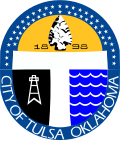19th century

- 1836 – Creek people begin to settle the town of Tulasi after their expulsion from the Southeastern United States. [2]
- 1861 – Battle of Round Mountain and Battle of Chusto-Talasah – Civil War battles occur north of Tulsa.: Goble, [28]
- March 25, 1879 – First post office established at Perryman ranch. [3] [4]
- 1882 –
- Atlantic & Pacific Railroad tracks laid from Vinita. [5]
- T. J. (Jeff) Archer builds first mercantile store in downtown Tulsa
- 1884 – Presbyterian church founded a mission day school that became the first public school after Tulsa was incorporated.
- 1886 – First Methodist Episcopal Church organized in December in Tulsey Town, Creek Nation. [6]
- 1887 – Tulsa founded. [7]
- 1893 – The Tulsa Review is the first newspaper published in Tulsa. [8] [9]
- 1895 – The New Era newspaper opens. It later renames to the Indian Republican and Tulsa World . [8] [9]
- 1898
- Town is officially incorporated on January 18. [10]
- Edward E. Calkins becomes first mayor. [11]
- Population reported as 1,100.
- 1899
- First mass said at Holy Family Church. [12]
- Robert H. Hall built the first telephone system in Tulsa, serving 80 subscribers.
- R. N. Bynum becomes second mayor. [11]
- Presbyterian mission school closed permanently after 1898-99 session; building purchased by J. M. Hall and 3 other men and reopened as first public school, beginning Tulsa Public Schools system. [13]
- 1900








